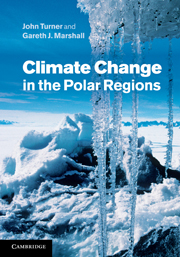Book contents
2 - Polar climate data and models
Published online by Cambridge University Press: 07 September 2011
Summary
Introduction
In this chapter we describe the main types of data available for the study of climate change within the polar regions. In comparison with most other regions of the Earth the time-series of ‘traditional’, in-situ instrumental observations is relatively short, particularly in Antarctica where most stations have only been operating for about 50 years. With short records it is more difficult to determine whether recent trends are significant, particularly for regions where there is high natural climate variability, such as the Antarctic Peninsula. One way of extending climate records is to use ‘proxy’ climate data; for example, the commercial whaling expeditions in both the Arctic and Antarctic provide historical data about the position of the sea ice edge, where the greatest amount of hunting took place.
The inhospitable nature of the polar regions means that conducting science in such areas can be very expensive. Thus, there are relatively few surface meteorological stations compared with the mid latitude and tropical areas. This is illustrated in Fig. 2.1, which shows the coverage of surface, ship and aircraft observations assimilated into the European Centre for Medium-range Weather Forecasts (ECMWF) model at 00 GMT 12 July 2010. In recent years advances in technology have allowed the deployment of autonomous automatic weather stations (AWSs) and these are particularly useful in the polar regions as they can be sited in very remote locations. The majority of the synoptic reports in Antarctica situated away from the coast are from such AWSs.
- Type
- Chapter
- Information
- Climate Change in the Polar Regions , pp. 16 - 60Publisher: Cambridge University PressPrint publication year: 2011



